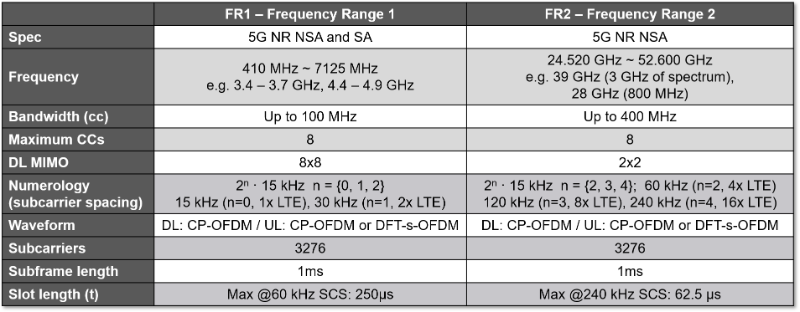
5G NR: A Step-Function Increase Over 4G LTE
5G specifications are driven by two key organizations - The International Telecommunication Union (ITU) and the 3rd Generation Partnership Project (3GPP). The ITU established the vision for 5G with the International Mobile Telecommunications for the year 2020 (IMT-2020) standard in 2015. The 3GPP organizes the development and management of mobile communications standards. This organization writes the 5G specifications and issues them through releases. Release 15 is the first release for the 5G standard, 5G New Radio (NR), and covers most of the physical layer definitions. Release 16 and 17 add features for new verticals as well as improvements over existing ones.
5G NR Release 15 completed in mid-2018. It focuses on the enhanced mobile broadband (eMBB) use case and low latency aspects. Release 15 minimizes changes to the core architecture by leveraging the 4G Long Term Evolution (LTE) core network. Release 16 completed in mid-2020. This release enables new verticals including industrial Internet of things (IIoT) and vehicle-to-everything (V2X) applications. Release 16 introduces new layers, the use of millimeter-wave (mmWave) 28, 37, and 39 GHz channels, and unlicensed spectrum.
5G NR represents a step-function increase in many technical aspects compared to the previous generation standard, starting with the use of two frequency ranges. Frequency range 1 (FR1) goes from 410 MHz to 7.125 GHz and frequency range 2 (FR2), commonly referred to as mmWave, goes from 24.25 to 52.6 GHz. Channel bandwidths for a single component carrier (CC) increase up to 400 MHz and 3D beamforming improves greatly, but there are other differences. The maximum number of CCs increases from 5 to 8, subcarrier spacing becomes flexible, and the modulation scheme is now the same for the uplink and the downlink, with a simpler version available for power-efficient devices. Subframe length remains the same at 1 ms, but latency improves vastly, reducing from 10 ms to 1 ms. Slot length increases from 7 to 14 symbols, there are changes in the channel coding, and the initial access procedure now includes beamforming. Finally, duplexing expands to include dynamic time division duplexing (TDD).
Table 1. 5G NR versus LTE Comparison

It is also important to understand the differences between frequency ranges for 5G NR, outside of the frequency and bandwidth aspects. The maximum number of CCs is the same across both frequency ranges but downlink multiple-input/multiple output (MIMO) differs. FR1 specifies 8x8 MIMO while FR2 specifies 2x2 MIMO.
Channel properties are the key reason for using different MIMO variants between the two frequency ranges. FR1 deployment scenarios include macro cells and high user mobility. These scenarios are meant to cover tens of users over a very large area. Higher-order MIMO enables spatial multiplexing and multi-user MIMO (MU-MIMO). Channels with rich multipath propagation facilitate spatial multiplexing.
FR2 deployment scenarios include small cells and low user mobility. Using less antennas is enough. The number of simultaneous users is low and over a small coverage area. Lower-order MIMO enables the use of beamforming for single users. Few propagation paths in the channels make beamforming easier.
Numerology is another major difference between the two 5G NR frequency ranges. FR1 uses 15, 30, and 60 kHz subcarrier spacing while FR2 can use 60, 120, 240, and 480 kHz subcarrier spacing. Initial access is limited to specific numerologies and cyclic prefix is available as an extended format for specific numerologies only.
Different numerologies can be used for different procedures and parts of 5G. Different subcarrier spacing enables specific use cases. For example, a smaller bandwidth signal increases transmission length but reduces latency while a high numerology enables lower latency.
Table 2. 5G NR FR1 versus FR2 Comparison

Compared to 4G LTE, 5G NR offers significant potential by enabling multiple use cases. However, the standard is complex because the requirements of the use cases vary greatly. For more information on the 5G NR standard, dowload our First Steps in 5G white paper series: